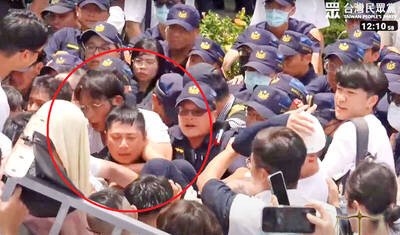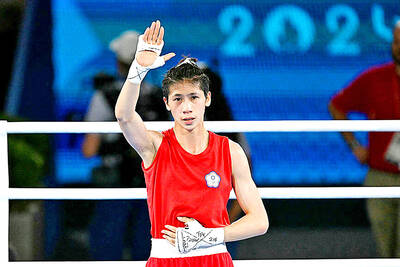There are about 11 billion barrels of oil and 190 trillion cubic feet of natural gas under the South China Sea, according to a US government report released on Thursday.
The reported oil reserves are higher than the proven oil reserves of Mexico, Angola and Azerbaijan, slightly less than the proven 14.8 billion barrels of oil in China and about half of the US’ proven oil reserves of 20.6 billion barrels, according to the CIA’s World Factbook.
The numbers — based on estimates by the US Energy Information Administration (EIA) — are significantly higher than the previously issued private US estimates of 2.5 billion barrels of oil.
“It is difficult to determine the amount of oil and natural gas in the South China Sea because of under-exploration and territorial disputes,” the EIA report says.
The estimates include both proven and probable reserves, and the report says there may be additional hydrocarbons in underexplored areas.
In November, the Chinese National Offshore Oil Corp (中國海洋石油), estimated the area held about 125 billion barrels of oil and 500 trillion cubic feet of natural gas in undiscovered resources. US experts believe these figures to be far too high.
“Stretching from Singapore and the Strait of Malacca in the southwest to the Strait of Taiwan in the northeast, the South China Sea is one of the most important trade routes in the world,” the report says.
It notes that the area includes several hundred small islands, rocks and reefs, with the majority in the Paracel (Xisha Islands, 西沙群島) and Spratly (Nansha Islands, 南沙群島) island chains.
“Several of the countries bordering the sea declare ownership of the islands to claim the surrounding sea and its resources,” the report says.
The EIA estimates the region around the Spratly Islands to have virtually no proven or probable oil reserves.
However, the US Geological Survey estimates there could be 2.5 billion barrels of oil and 25.5 trillion cubic feet of natural gas in undiscovered resources.
According to the new report, evidence suggests that most of these resources are likely located in the contested Reed Bank (Lile Bank, 禮樂灘) at the northeast end of the Spratlys, which is claimed by Taiwan, China and the Philippines.
The Paracel Island territory does not have significant discovered conventional oil and gas fields and has no proven or probable reserves.
“EIA estimates the South China Sea to be more viable as a source of natural gas than as a source of oil,” the report says.
It says producers would have to construct expensive undersea pipelines to carry the gas to processing facilities.
Submarine valleys and strong currents also present formidable geological problems to effective deepwater gas infrastructure.
“The region is also prone to typhoons and tropical storms, precluding cheaper rigid drilling and production platforms,” the report says.
It says that Taiwan, like China, asserts “historic” sovereignty over all features drawn within the dashes originally shown on a map published by the Chinese Nationalist Party (KMT) government in 1947 — including the Spratly Islands, the Paracel Islands, the Pratas Islands (Dongsha Islands, 東沙群島) and the Scarborough Shoal (Huangyan Island, 黃岩島).

FIREPOWER: On top of the torpedoes, the military would procure Kestrel II anti-tank weapons systems to replace aging license-produced M72 LAW launchers Taiwan is to receive US-made Mark 48 torpedoes and training simulators over the next three years, following delays that hampered the navy’s operational readiness, the Ministry of National Defense’s latest budget proposal showed. The navy next year would acquire four training simulator systems for the torpedoes and take receipt of 14 torpedoes in 2027 and 10 torpedoes in 2028, the ministry said in its budget for the next fiscal year. The torpedoes would almost certainly be utilized in the navy’s two upgraded Chien Lung-class submarines and the indigenously developed Hai Kun, should the attack sub successfully reach operational status. US President Donald Trump

TPP RALLY: The clashes occurred near the Chiang Kai-shek Memorial Hall on Saturday at a rally to mark the anniversary of a raid on former TPP chairman Ko Wen-je People who clashed with police at a Taiwan People’s Party (TPP) rally in Taipei on Saturday would be referred to prosecutors for investigation, said the Ministry of the Interior, which oversees the National Police Agency. Taipei police had collected evidence of obstruction of public officials and coercion by “disorderly” demonstrators, as well as contraventions of the Assembly and Parade Act (集會遊行法), the ministry said in a statement on Sunday. It added that amid the “severe pushing and jostling” by some demonstrators, eight police officers were injured, including one who was sent to hospital after losing consciousness, allegedly due to heat stroke. The Taipei

NO LIVERPOOL TRIP: Taiwan’s Lin Yu-ting, who won a gold medal in the boxing at the Paris Olympics, was embroiled in controversy about her gender at that event Taiwanese boxer Lin Yu-ting (林郁婷) will not attend this year’s World Boxing Championships in Liverpool, England, due to a lack of response regarding her sex tests from the organizer, World Boxing. The national boxing association on Monday said that it had submitted all required tests to World Boxing, but had not received a response as of Monday, the departure day for the championships. It said the decision for Lin to skip the championships was made to protect its athletes, ensuring they would not travel to the UK without a guarantee of participation. Lin, who won a gold medal in the women’s 57kg boxing

The US has revoked Taiwan Semiconductor Manufacturing Co’s (TSMC, 台積電) authorization to freely ship essential gear to its main Chinese chipmaking base, potentially curtailing its production capabilities at that older-generation facility. American officials recently informed TSMC of their decision to end the Taiwanese chipmaker’s so-called validated end user (VEU) status for its Nanjing site. The action mirrors steps the US took to revoke VEU designations for China facilities owned by Samsung Electronics Co and SK Hynix Inc. The waivers are set to expire in about four months. “TSMC has received notification from the US Government that our VEU authorization for TSMC Nanjing